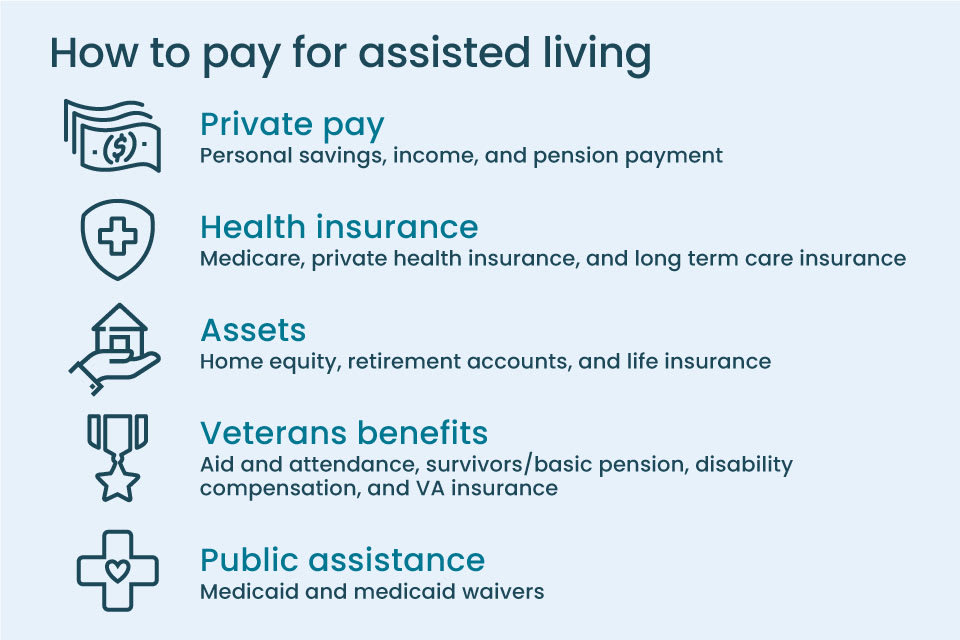Make the best senior care decision

How to Pay for Assisted Living: A Comprehensive Guide

Making the decision to move to an assisted living community can be a needed, positive change, and hopefully your loved one is looking forward to starting a new chapter in their life. However, it’s also expensive, with a national median cost of more than $4,000 per month. Many families are surprised and disappointed to learn it’s not fully covered by Medicare, as they may not have that money in the bank. Luckily, there are several ways to cover costs and save money on your loved one’s care. Learning about different pricing models and how to budget for assisted living can make choosing the right community a little easier.
Key Takeaways
- Many people rely on private funds for assisted living. This could include using personal savings, pension payments, or retirement accounts.
- Some people find other ways to use existing assets. This could include a reverse mortgage or selling a life insurance policy.
- Get creative to save on costs. You can ask communities about price flexibility or take advantage of tax credits.
- Find assisted living that fits your budget. Narrow your search based on price range and other important community features.
Who pays for assisted living?
Most families use private funds to pay for assisted living. This includes personal savings, pension payments, retirement accounts, or a combination of any of these. Though many seniors save for retirement over the years, family members often contribute to elder care costs. Before choosing a community for your loved one, consider how you’ll pay for assisted living. Determine what funds are available through insurance, savings accounts, and family contributions. Once you have a rough idea of your budget, consider which features your relative prefers and how much care they’ll need.
Paying for assisted living: Where to start

The national median cost of assisted living is $4,500 a month, according to Genworth’s 2021 Cost of Care Survey.[01] Depending on where you live and the care needs of your loved one, you may pay less or more than that amount. The median cost is an excellent starting point to keep in mind as you work on creating your budget. Even if the cost of living is low in your area, the cost of your loved one’s care might be more than you expect if they need a significant amount of hands-on assistance.
To determine a new resident’s level of care, you should expect the community to conduct a care assessment. Some communities offer different levels of care at different prices or may offer a base care package that includes the option to add on additional care services. Should your loved one need more care over time, their monthly bill may increase. Planning for these changes now can save you from worrying over the cost later. As you tour communities, you’ll want to ask several questions about budgeting, such as the ones found on A Place for Mom’s Assisted Living Budget Planner.
Private pay financing options for assisted living
Insurance, home equity, and other benefits can help cover the cost of assisted living.
Using health insurance to pay for medical aspects of care
Older adults often rely on health insurance to cover medical procedures, hospital stays, and other care. Depending on your insurance policy, you may be able to claim some medical aspects of care.
The solution varies by plan:
- Medicare may cover some of the health care your loved one receives in the assisted living community. For example, if your relative needs help bathing, dressing, and administering insulin, Medicare won’t cover the cost of personal care assistance, but you may be able to claim the injection fees.
- Private health insurance, like Blue Cross, Aetna, or Humana, may cover some skilled nursing or health care costs, but it rarely pays for personal care in assisted living. You’ll need to contact the insurer directly for more details about your loved one’s policy.
- Long-term care insurance generally goes into effect when your relative can no longer perform two activities of daily living (ADLs), such as bathing or dressing. Your loved one likely would’ve had to register and pay for a policy before the age of 60. If your loved one invested in long-term care insurance, review their policy to see whether assisted living is covered. This type of policy does provide more benefits than most, but it comes with considerable premiums over the years.
Using life insurance to finance assisted living
Many people don’t realize a senior’s life insurance policy, or that of a family member, can be used to pay for assisted living. You can sell a policy to a third party for market value and use the proceeds to fund a long-term care benefit plan while retaining some death benefits. Another option is “surrendering” a life insurance policy to the life insurance company for cash value. In this case, you give up ownership and won’t receive any benefits upon death.[02]
Using home equity to pay for assisted living
If your loved one owns a home or other property, they may be able to cover assisted living costs with home equity. Some ways to leverage homeownership to pay for assisted living include:
- Bridge loans. This short-term loan is ideal for urgent situations and can help homeowners gain cash flow quickly. Bridge loans can be used to pay for assisted living while you’re liquidating assets or waiting for the home to sell. However, someone must be able to make payments on the loan until the house is sold.
- Reverse mortgage. This option allows a spouse or adult children to remain in the home. Reverse mortgages tap into home equity, so the borrower can receive money either as a lump sum or as needed to supplement income. Unfortunately, many scams target seniors interested in reverse mortgages. Be sure to work with a reputable bank you and your loved one trust.
- Sell or rent your home. Selling a home can free up assets to pay for assisted living or other elder care. However, a spouse or relative may still live in the house or want to keep the property in the family. If the home is vacant, but you aren’t ready to sell, consider renting.

Let our care assessment guide you
Our free tool provides options, advice, and next steps based on your unique situation.
Using other benefits to fund assisted living
If your loved one served in the military, worked for the government, or was a railroad employee, they may be eligible for a stipend to cover some assisted living costs.
Wartime veterans and spouses may qualify for a pension program through the Department of Veterans Affairs (VA) to offset the cost of senior care. Our Guide to VA Benefits and Long-Term Care includes detailed information about how to apply, what’s included, and eligibility.
Federal and postal employees and annuitants, as well as qualified relatives, can apply for Federal Long Term Care Insurance (FLTCI), which helps pay for future long-term care expenses. Employees have to apply for FLTCI before retirement, and certain medical conditions may prevent approval.
Public pay: Using Medicaid for assisted living
Medicaid covers medical assisted living costs for qualifying low-income seniors. Medicaid is a state-regulated resource, so applying and qualifying, along with what’s covered, will vary from state to state. Not every assisted living community accepts Medicaid, however. If you can’t find a Medicaid-approved community, you may be able to apply for a waiver to help you find care.

Talk with a Senior Living Advisor
Our advisors help 300,000 families each year find the right senior care for their loved ones.
Tips to stretch your assisted living budget
Once you review your loved one’s assets and what other family members are able to contribute, you’ll have a good idea of your assisted living budget. Collect information for each account, and gather it together into one document so you can clearly see how many sources you can draw from, including retirement accounts, insurance policies, home equity, and family contributions. It might help to choose one account to draw from first while working on freeing up cash from other sources, such as selling a home.
When you’re creating your budget, keep in mind how long your loved one might be in their chosen community. Many factors determine how long a senior lives in a senior living community, but you can expect an average of two to three years of care.
Even with the above benefits, senior care can be expensive. Discover how to pay less for assisted living with these seven tips.
1. Ask about price flexibility and specials
Depending on the location and time of year, communities may be willing to offer a discount to fill vacant rooms. Many facilities offer deals at the end of the month or during seasons with lower move-in rates. Ask these questions during your tour:
- Are there any move-in incentives?
- Do you have any specials available?
- Is the community willing to negotiate its monthly price?
- Can the entrance fee be waived?
- Can you offer a month free if we sign up for an extended lease?
- Are there any discounts available with lump-sum payments?
2. Compare a la carte costs with inclusive pricing
Some assisted living communities allow families to select either an all-inclusive rent fee or to pay for services individually based on need. Figuring out the best option for your needs will help you plan and budget more efficiently. The two main payment models are:
- A la carte. This option allows you to purchase services or items separately based on need, including laundry or bathing services, additional housekeeping, meal delivery, and more.
- All-inclusive. In this model, a monthly fee covers a range of services so there are no surprise charges. Be sure to ask what’s included.
If family members are available to help with services like housekeeping or personal grooming, a la carte payments may save money in the long run. However, all-inclusive rent payments are often a better value if you expect care needs to change over time.
3. Consider a roommate
In many senior living communities, a shared space is more cost-effective than a single room or apartment. In addition to saving money, sharing a room can be safer and prevent loneliness, a common problem among the elderly. Many seniors do look forward to their own private space, so it’s best to look at this option if you think it would suit your loved one’s personality.
4. Enroll in discount programs for essentials for low-income seniors
Your loved one may be eligible to receive funds or assistance through senior benefit programs, allowing them to reallocate money normally spent on necessities to cover assisted living costs.
The National Council on Aging (NCOA) lists several benefits programs for vulnerable adults or low-income seniors to save costs on drug prescriptions, food, hearing care, dental care, vision coverage, and energy bills.
5. Save on moving expenses
Hiring a senior move manager can help cover downsizing and transition costs. Move managers may be able to help you determine the least expensive time to move, the best community options in your area, and how to sell possessions to help cover assisted living costs.
Most senior move managers partner with estate agents to help organize sales of personal collections, antiques, cars, and more. Many assisted living communities offer referral discounts for senior-specific relocation services.
6. Explore tax credits and deductions
One surprising way to recoup assisted living costs is through senior and caregiver tax credits. Seniors who meet the IRS’ definition of “chronically ill,” or who need help with two or more ADLs, may qualify for medical tax deductions.[05] Relatives who pay for at least 50% of an elderly loved one’s care may also be eligible for caregiver tax credits.
7. Turn to assisted living resources
A Place for Mom’s Senior Living Advisors have experience helping families find affordable senior living. They can offer you community suggestions to fit your budget while providing your loved one with an enriching community to live in — all at no cost to your family.
You can also visit AgingCare’s Caregiver Forum to find out how other caregivers have handled care for their loved one. Sometimes, your best support can come from a group of others who are making the same decisions you are.
Recommended For You
Find Assisted Living Near Me
<p><span data-sheets-value="{"1":2,"2":"View assisted living facilities"}" data-sheets-userformat="{"2":573,"3":{"1":0},"5":{"1":[{"1":2,"2":0,"5":{"1":2,"2":0}},{"1":0,"2":0,"3":3},{"1":1,"2":0,"4":1}]},"6":{"1":[{"1":2,"2":0,"5":{"1":2,"2":0}},{"1":0,"2":0,"3":3},{"1":1,"2":0,"4":1}]},"7":{"1":[{"1":2,"2":0,"5":{"1":2,"2":0}},{"1":0,"2":0,"3":3},{"1":1,"2":0,"4":3}]},"8":{"1":[{"1":2,"2":0,"5":{"1":2,"2":0}},{"1":0,"2":0,"3":3},{"1":1,"2":0,"4":3}]},"12":0}">View assisted living facilities</span></p>
Or search a different zip code
Genworth. (2021, November). Cost of Care.
Administration for Community Living. (2020, February 18). Using life insurance to pay for long-term care.
U.S. Office of Personnel Management. Federal long term care insurance program (FLTCIP).
Administration for Community Living. (2020, February 18). How much care will you need?
IRS. (2022, January 13). Publication 502 (2021), Medical and Dental Expenses.
The information contained in this article is for informational purposes only and is not intended to constitute medical, legal or financial advice or create a professional relationship between A Place for Mom and the reader. Always seek the advice of your health care provider, attorney or financial advisor with respect to any particular matter and do not act or refrain from acting on the basis of anything you have read on this site. Links to third-party websites are only for the convenience of the reader; A Place for Mom does not recommend or endorse the contents of the third-party sites.